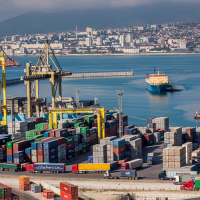Securing the Supply Chain: Best Practices in Cybersecurity and Risk Management for Competitive Advantage
- Supply Chain
- Security
Key Takeaways:
- 89% of Digital Inventory Report respondents say data security is important to extremely important to their inventory operations.
- Supply chain risk management begins with an understanding of the risks to your organization and a strong proactive plan to mitigate risk.
- Cybersecurity is a vital component of a supply chain risk management plan.

Supply chain issues remain a real and present challenge in 2023. Businesses looking to gain a competitive advantage must put a focus on improving supply chain processes and operations, including an emphasis on technology and automation.
Critical to these improved operations is the role of security in today’s global economy. In fact, 89% of Digital Inventory Report respondents say data security is important or extremely important to their inventory operations.
The reality is the supply chain is an area rife with vulnerabilities. With numerous vendors along the pipeline, the risk of an attack increases without proper prevention and mitigation procedures in place.
In 2022, supply chain attacks surpassed malware-based attacks by 40%. This means more than 10 million people were impacted by supply chain attacks last year.
Forward-thinking organizations will prioritize supply chain risk management and cybersecurity in their operations. After all, security is critical to overall business success.
Let’s break down supply chain risk management best practices, cybersecurity guidelines, and the integration of the two to create lasting change.
Supply Chain Risk Management (SCRM) Best Practices
According to Gartner, 89% of companies have experienced a supplier risk event within the past five years. Despite these overwhelming numbers, many lack proactive plans to prepare let alone abate a risk.
And in a world of near-constant market disruptions (shipping delays, natural disasters, inflation, fluctuating customer demand), a proactive supply chain risk management strategy is critical.
Supply chain risk management involves the identification, evaluation, and mitigation of risks to an organization’s supply chain. Putting a focus on SCRM allows organizations to embrace resiliency and prepare for the inevitable before it occurs.
SCRM Process
The best way to adopt SCRM is through a basic understanding of the inherent risks to your organization. To do this, organizations should:
- Identify known risks by mapping out each point along the supply chain for all major products.
- Document the level of impact on the organization should the risk occur and how ready the organization is to mitigate the risk in a timely fashion.
- Consistently monitor all known risks and integrate regular reviews of the full process with key stakeholders.
But what about unknown risks to the organization? After all, external market factors and changes in demand are hard to track.
Building strong, proactive risk management processes into your overall supply chain structure will help you better respond when these types of challenges arise.

Read about 4 more tips to mitigate supply chain risks.
GO NOW »Best Practices for Supply Chain Risk Management
The best and most cost-effective way to mitigate risk is by being proactive. Proactive supply chain risk management results in 50% less spend when it comes to supplier disruptions according to Deloitte.
Proactive SCRM takes a beginning-to-end approach, coupled with data-driven information. It allows organizations to:
- Determine key risk areas to monitor due to their critical impact to your organization or their likelihood to be exposed to risk.
- Compile data about specific suppliers more prone to risk and convert this data into usable insights to help track potential risk.
- Share the information with key identified stakeholders who can make decisions in real-time before, during and after risk occurs.
This begins with identifying the right cross-functional team to deal with risk situations as they arise. These individuals must be empowered with the right data in order to make strategic decisions and understand the impact of potential or impending risk.
They also must understand value across the supply chain. By having a clear lens into the whole process, a team can easily identify potential areas of impact from sourcing to production.
While this may seem like a lot, the implementation of technology can help streamline many of these areas. In fact, utilizing technology in SCRM has been found to double the effectiveness of supplier risk tactics.
Digitizing manual processes is the first step in data security. By implementing technology solutions that optimize your supply chain, you enable a more reliable flow of data, leading to enhanced decision-making.
In addition, automation can help process data and identify potential issues early, before problems arise.

How to Mitigate Supply Chain Disruptions with Mobile Barcoding
READ NOW »Cybersecurity Approach
The reality is, it’s not a matter of if, but when a business will be subject to a cybersecurity breach. Research has shown that cybercrime will cost the world $10.5 trillion by 2025.
Threats to the supply chain continue to rise as more and more supply chains turn digital. Without the necessary infrastructure, automation and staff training, supply chains can become increasingly vulnerable to a cyber-attack. More than 60% of organizations audited or reported on supplier security in 2022.
Cybersecurity Processes for Supply Chain
In order to best protect your supply chain, it’s important to prioritize the following:
- Prevention methods, including assessing cybersecurity risk areas before they happen and running practice exercises to expose future vulnerabilities.
- Budget allocation to properly address areas early on, before an attack occurs.
- Compliance across vendor relationships, ensuring they boost an organization’s data security measures rather than putting them more at risk.
- Continuous auditing, monitoring, and reporting throughout the supply chain, including unauthorized access.
- Securing data collection and transmission, especially with remote access.
- Employee engagement and adherence to robust security policies, regardless of position.
The Use of Technology in Cybersecurity Processes
Technology can help organizations be proactive in their cybersecurity processes. It’s important, however, to properly research solutions and their security protocols. Otherwise, you’ll ultimately put the organization at more risk.
Mobile data collection software, for instance, allows organizations to transmit sensitive data throughout their enterprise, but safely and securely. Look for software that secures data at rest, enables single sign-on and traffic encryption, and serves as a proxy.

Solving Common Supply Chain Management Problems with Mobile Data Collection Software
READ NOW »Further, automating data flow can help address shifting market demands and lead to significant time and cost savings. By having a reliable view of inventory, supply chain flow, and more, organizations can quickly adjust and better forecast to reduce operational risk.
Ultimately, cybersecurity threats are ever-evolving. Organizations need to stay current on cybersecurity issues while also choosing technology that will be up-to-date as risks change.
Integrating SCRM and Cybersecurity
SCRM and cybersecurity must work together to keep an organization secure. As many organizations utilize third-party vendors, the potential for increased cybersecurity risk also grows. Having a supply chain risk management strategy that includes cybersecurity risks is vital.
To integrate cybersecurity and SCRM, ensure that common cyber risks are included in the overall supply chain risk management plan. These include:
- Data breaches
- Cyber breaches
- Ransomware attacks
- Malware attacks
Next, ensure the CIO and supply chain professionals are working together toward a common set of goals. Together these two groups can create compliance standards for all vendors along the product pipeline, define user roles and define who has access to what data.
In addition, providing regular security training for all employees, both on cyber and general risk best practices is critical. Informed employees are better able to spot a potential risk and allow organizations to resolve it quickly.
Finally, ensure the risk management plan includes cybersecurity risk areas and identifies how those areas will impact the supply chain. Ultimately the goal of this plan is to identify the areas most prone to risk and establish a protocol to mitigate that risk quickly and efficiently.
Best Practices for Integrating Cybersecurity into SCRM
Here are three tips when it comes to integrating cybersecurity and SCRM:
- Understand the risk in your business-critical systems. Knowing what information is available and how software systems grant access to it (such as ERPs, data collection software, etc.) will help you see areas of risk across the supply chain. Further, have a comprehensive understanding of where each of these is used along the supply chain in order to secure it in the event of a breach.
- Make supply chain risk management a company-wide issue. Protecting the supply chain, and the organization as a whole should be everyone’s job. Train employees to spot common issues and help them understand the impact a breach could have at every point in the process.
- Choose your stakeholder group carefully. The supply chain is the lifeblood of the organization and impacts more than just IT. Ensure your risk management plan involves more than just your IT or security teams and clearly defines roles and responsibilities when a breach occurs. Partner with external vendors as necessary.
Cybersecurity Case Studies
Cybersecurity and the need for integrated risk management techniques are becoming more necessary, and more challenging than ever. Global scale attacks like Solar Winds demonstrate the startling reality that hackers are becoming increasingly sophisticated.
That’s why forward-thinking organizations need to plan and prepare to assess, mitigate and respond swiftly to risk. And this begins with a clear and accurate picture of your data.
When it comes to mobile inventory solutions, look for those that not only have existing security protocols but also the ability to add in additional capabilities.
For instance, Grupo Cementos de Chihuahua implemented RFgen Mobile Foundations for SAP, which included SAP-certified mobile inventory apps. Not only did the solution help the company gain real-time inventory tracking and visibility, but it also helped secure data access from cyber threats.
The Importance of Security in Your Supply Chain
Ultimately, the supply chain is only as strong as its weakest part. An understanding of risk areas can help strengthen the supply chain and ultimately grow business.
This begins with a proactive, strategic approach, an understanding of known risks and a detailed plan to prevent, detect and mitigate unknown risks to the organization.
Companies should also utilize technology, data, third-party risk management, and security awareness and training to create a culture of risk prevention and trust.




